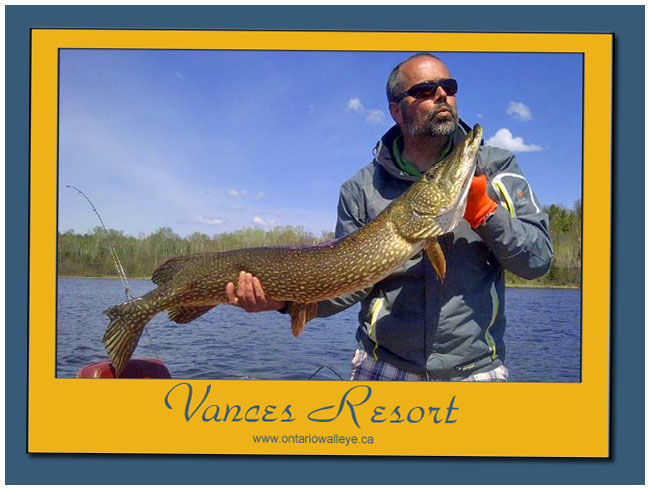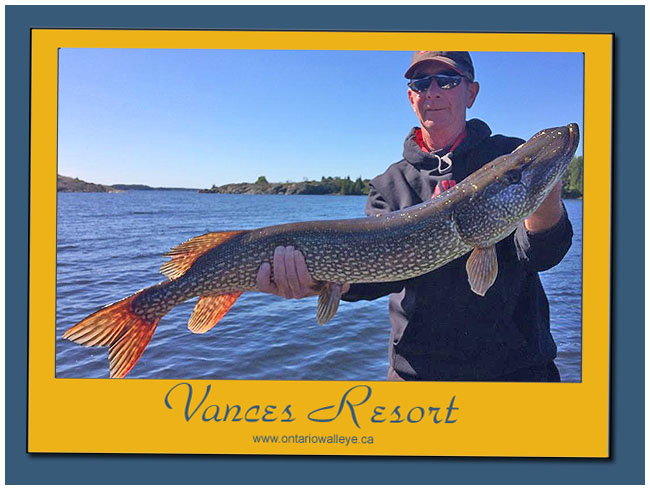
 The Spanish River and areas of the North Channel have incredible Northern Pike fishing. Lots of weedy bays and drop-offs create an awesome environment for pike to grow big. Over 15 pound Northern Pike are common with lots of 20-pounders being caught and released all summer.
The Spanish River and areas of the North Channel have incredible Northern Pike fishing. Lots of weedy bays and drop-offs create an awesome environment for pike to grow big. Over 15 pound Northern Pike are common with lots of 20-pounders being caught and released all summer.
It's easy to catch lots of smaller good eating size pike. Pike in the 2 to 4 pound range in our water system taste very much like Walleye when they are fresh. Unfortunately, pike don't taste as good after they have been frozen so it's best to get your fill of fresh pike while you are here at the lodge.
• View Regulations for the Spanish River (zone 10 - Adobe .pdf)
• View Regulations for North Channel & Georgian Bay (zone 14 - Adobe .pdf)
• View Big Map of North Channel
 Download Adobe .pdf Reader for Free
Download Adobe .pdf Reader for Free
There are many places where you will find Northern Pike in Northern Ontario Lakes. Generally, you will find small to medium size pike in the back of bays where there is thick weeds, lily pads and wild rice. The small to medium size pike are feeding on small minnows, bugs, frogs and each other. When you come out to the edge of the weeds, the pike will get bigger because the pike have the food of the bay to their back and also have the chance of taking a small Walleye swimming by the outside of the weeds. So where are the big pike?
Big pike generally do not bother with small minnows, frogs and bugs. Their main food is Walleyes. The big pike will hang out where they can ambush Walleyes. The prime ambush area is points leading into bays. They will also hang around rocky points, shoals, islands and other places where there are Walleyes. The best place to get a big trophy pike is at the mouth of a stream or river, narrows between islands and water-flow between lakes. The big pike just sit there waiting for Walleyes to swim through. Walleyes tend to migrate around a lake all year, whether it's moving to find cooler water, deeper water, more food or even finding their spawning grounds.
Of all the game fish you can catch in Ontario, Northern Pike are the easiest. Pike will hit just about any lure. The most popular lures for Pike are the "red & silver" and the yellow "five-of-diamonds" Daredevles. Pike also hit jigs, Rapalas and Thundersticks. Some of the biggest pike are caught with small jigs while Walleye fishing. It makes sense because the big pike will patrol the outer parameter of the schools of Walleyes.
Play with your bait: Pike will play with your bait. It's not uncommon for a big Pike to hit and let go several times before the bait is taken. With this in mind you have to show some patience. If you get a big pike on and then lose him, just wait a little while and he will hit again. Their appetites are so ferocious that they forget quickly and start to feed again. There are many reports by fisherman of catching the same pike over again.
 In Casting A Daredevle: One very effective way to maximize the attraction of a Daredevles or other spoons is to slap them. What you do is cast towards your target zone but cast up high so your lure falls into the area you want to fish. When the lure is about 2 or 3 feet above the water, jerk your line towards you. This makes the lure slap on the surface. If you are doing it right, you can hear the Daredevle slap. The sound of a spoon slapping on the surface seems to attract pike and/or trigger a feeding response.
In Casting A Daredevle: One very effective way to maximize the attraction of a Daredevles or other spoons is to slap them. What you do is cast towards your target zone but cast up high so your lure falls into the area you want to fish. When the lure is about 2 or 3 feet above the water, jerk your line towards you. This makes the lure slap on the surface. If you are doing it right, you can hear the Daredevle slap. The sound of a spoon slapping on the surface seems to attract pike and/or trigger a feeding response.
In Northern Ontario, there are generally three types of water. Some lakes are so clear that you can see the bottom 80 feet down. Other shallow lakes can be murky or muddy for days or weeks after a big storm. Many lakes have a wine-red color, which is caused by dissolved iron in the water. With clear water, the red and silver color works best. With muddy or iron-rich water, a yellow Five-of-Diamonds Daredevle seems to work better. In muddy or iron-rich water, rattle baits are even better as the pike can locate the lure by sound.
Musky and Northern Pike look very similar. Did you know that they are not genetically related? They look the same because they evolved in similar environments. Walleye (Yellow Pickerel) and the Yellow Perch are related even though they look very different.